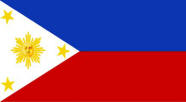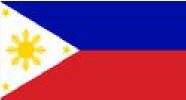|







| |
PHILIPPINE FLAG PICTURES
EVOLUTION of the FILIPINO FLAG
|
|
 |
The first Filipino flag can be traced from the time of the
Andres Bonifacio's secret society named:
Kataastaasang Kagalanggalang Katipunan ng mga Anak ng Bayan (Highest and Most Honorable Society of the Sons of the Nation) or the
Katipunan or KKK for short. Benita Rodriquez and Bonifacio's wife,
Gregoria de Jesus, made the first Filipino flag. |
|
 |
The first Philippine flags was made of red cloth with white KKK initials sewn in white. The red color
symbolized the blood of the members of the Katipunan in which inductee to the society signed in their names with their own blood. |
|
 |
The
Filipino flag had variations (from 1892 to 1896).
Some members arranged the KKK in a triangle while some generals of the revolution designed their own flags.
|
|
 |
Of note is the black banner of General Mariano Llanera in Nueva Ecija with a letter K
and a skull with two cross bones underneath. |
|
 |
Another variation of the Filipino flag was that of General Pio del Pilar.
It had an equilateral triangle with a K at each angle with a rising sun behind a mountain.
|
|
 |
In this Philippine flag picture, the Sun with the
KKK underneath was also a derivative of previous Filipino flags. |
|
 |
In 1896, the Magdalo faction of the Katipunan in Cavite headed by General Emilio Aguinaldo had a red
ensign with a sun and at the center of the sun is the letter K written in the ancient Filipino alphabet. |
|
 |
Another variation is the Sun of Liberty of the Naic Assembly in 1897
and the flag used by the Republic of Biak-na Bato. |
|
 |
General Gregorio del Pilar also used another flag during the Battle of
Pasong Balite and at the Battle of Tirad Pass. This Filipino flag is similar to the flag of Cuba, according to del Pilar.
|
|
 |
In 1898
Emilio Aguinaldo while in exile in Hong Kong had a banner sewn with the triangle of the Masonry with the
mythical sun and face with 8 rays representing the 8 provinces that revolted against the
Spanish
rule (Manila, Cavite, Bulacan, Nueva Ecija,
Pampanga, Bataan, Laguna, and Batangas) and 3 stars representing the main island groups: Luzon, Visayas and Mindanao. |
|
 |
In 1936,
Manuel L. Quezon as president of the commonwealth, issued Executive Order 23 which contained the specifications
of the national flag. The banner is almost unchanged with a few exceptions, the most notable is the use of a plain sun without the face.
Retained were the while triangle, the sun and the stars and the blue and red stripes. The triangle stood for
equality and it's white color stood for purity. The blue stripe stood for peace and the red for courage.
|
|
In times of peace, the blue stripe is flown on top but in times of war, the banner is inverted with the red strip on the top.
The Philippine flag is the only flag to have this official dual display. |
●
Philippine History ●
Timeline of Philippine History ●
Philippine Presidents & Vice-Presidents ●
Philippine Flag Picture ● Filipino Flag ●
Philippine Statistics ●
Photos of Old Manila ●
Site Map ●
|